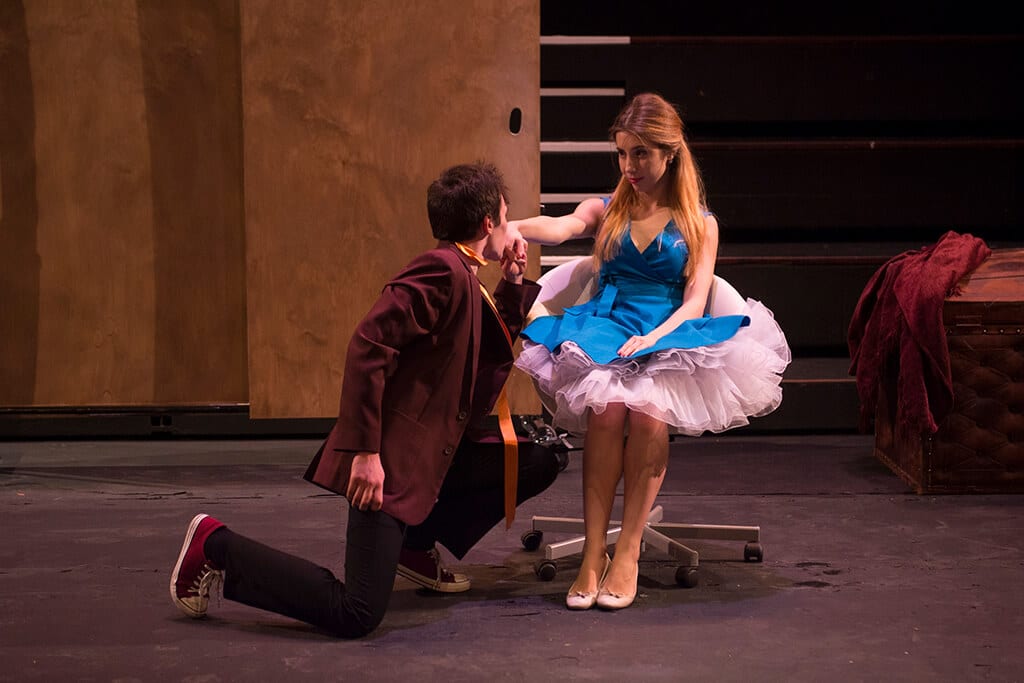The Marriage of Figaro by the Russian theatre company Xameleon Theatre Productions starts as a classic Commedia Dell’Arte performance – a man and a woman in traditional Italian masks perform a pantomime on the bare stage, using grotesque poses and exaggerated dance movements just like perfect innamorati.
A moment later Figaro (Vadim Bogdanov) and Susanna (Vlada Lemeshevskaya) remove their masks and carry on their love game, throwing distant kisses at each other as if they were heavy balls. Figaro places his mask in the middle of the up-stage, as if proclaiming the reign of the genre, and Count Almaviva (Oleg Hill) observes from a balcony how Figaro engages the characters surrounding him in joint movement and then twists a rod in his hand like a medieval juggler.
This impressive beginning gives the performance a swift tempo and a distinctive rhythm while employing the tradition of street theatre as well as a hint of Meyerhold’s biomechanics. However, the same style of acting isn’t followed throughout the performance, as the very next scene between Doctor Bartolo (Oleg Sidorchik) and Marcelina, performed by Irina Kara, wearing a short, tight bright green dress and speaking in a melodramatic manner, reminds us more of a cabaret or sitcom than of Commedia Dell’Arte. The tempo slows down and the rhythm slackens. This does not stop the audience from laughing out loud throughout the play and I have rarely seen an audience being so happy at the end of a three hour-long show.
The director Alexia Mankovskaya, who is a soprano as well as an actress, has a background in musical theatre, and it clearly shows when she transforms a part of the scene between the Doctor and Marcelina into one from an opera, as the characters simultaneously pronounce a different text to the same music as if demonstrating that they converse but don’t hear each other.
The music, mainly by Mozart and Rossini, is heard in different parts of the play, but it feels as if there is not enough of it, as it could have been used more actively in order to support a clearer structure of the performance. Some of the most successful scenes are those in which the light changes and the characters are transported out of the action into the world of their emotions. Thus, Cherubino (Nikita Zabolotny) does not need to say anything to express his feelings towards Countess Almaviva – an Italian love song from a loudspeaker does it for him.
The Countess, performed by Alexia Mankovskaya, is the most vivid and controversial character in the performance. This very beautiful actress is not afraid of pulling the most hilarious and ugly faces as the Countess keeps drowning her sorrows regarding her husband’s infidelity in wine. Having had too much to drink, she falls asleep in the middle of a scene and snores, only to wake up to wild hiccups. The actress demonstrates a brilliant comic, if not eccentric, side of her talent as her character fails to contain her excitement towards her young admirer or tries to tame her husband’s anger.
Count Almaviva, performed by Oleg Hill, a deeply lyrical and charismatic actor, who could be called the main male star of Russian theatre in London, is too sweet for us to believe in all the grief he puts young ladies through. Yes, he loves women and he has a twinkle in his eye as he looks at Susanna, but you can’t believe that he terrifies people around him. Sometimes his eyes do flash with anger, but he still remains very likeable, completely lacking the qualities of a scoundrel, that he really is.
The whole group of actors, led by the director, are great at making the performance very funny, full of witty jokes that feel almost improvised. I can’t describe in detail every actor in a short review, but their joint effort produces a great comic effect.
However, through laughter we tend to forget that this is one of the most significant plays not only in theatre history, but also in the political history of the modern world. Beaumarchais’ play captured the minds of his contemporaries and, as we all know, Figaro became the symbol of the French Revolution. The director does throw in a few jokes to make the subject of the play more in-tune with our time, but jokes about Brexit or Trump would have been more relevant than jokes about fish and chips.
Vadim Bogdanov’s Figaro is full of passion and light humour. The actor demonstrates not only versatility, but also an enviable physical form as his Figaro does press ups in order to seduce his own bride, pretending to be the Countess, to gasps from the female part of the audience. However, Figaro’s main monologue becomes the biggest challenge for the actor, who is given no support from any music or dramatic lighting. It is also not clear why Figaro seems to be the master of the play at the very beginning of the performance, as at the end it wasn’t he who fooled the Count, but the Countess and Susanna.
Vlada Lemeshevskaya, who is also the producer and artistic director of the company, performs Susanna with sharpness and wit, she seems almost too strong to be considered a victim of Almaviva. I have to add that the actress also masters to perfection the movements of a character from Commedia Dell’Arte, of which we are reminded once again at the end.
Although the performance on the whole is inconsistent in style it produces a great evening of entertainment.



